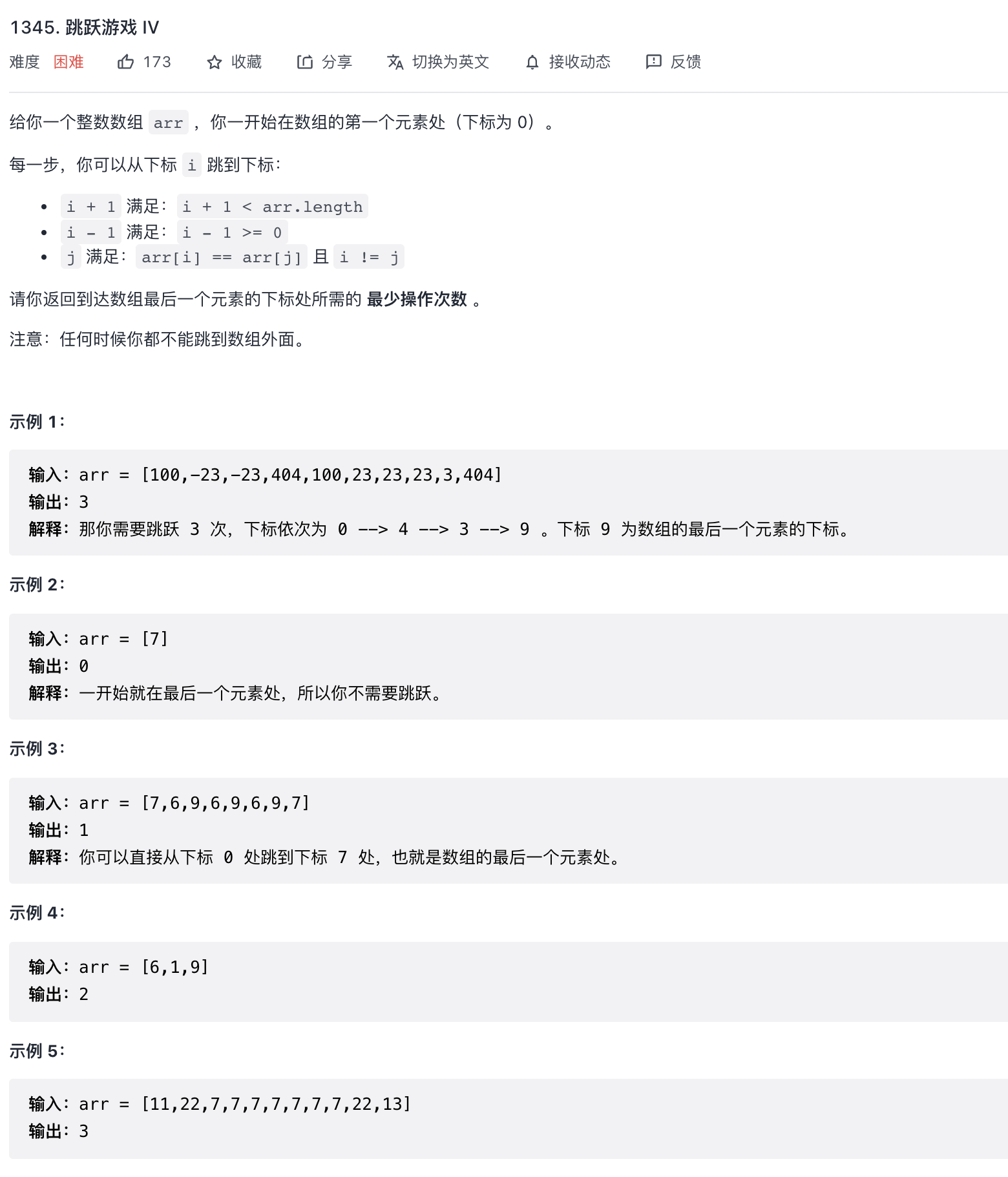题目
类型:广度优先搜索
解题思路
1、使用「哈希表」记录某个值有哪些下标
2、进行BFS,假如当前走到的位置为 t,将 t - 1、t + 1 和与 arr[t] 等值的位置进行入队,为了防止重复同队使用 dist 数组记录到达某个位置的最小步数(初始化为 INF),只有 dist[ne] 为 INF 时,该点没有被遍历过,可以入队并更新最小步数。
3、光使用 dist 还不能确保复杂度为 O(n),因为每次都需要遍历与 arr[t] 等值的下标,为确保等值下标的遍历只会发生一次,需要在将等值下标添加到队列后,将 arr[t] 从哈希表中移除
首次检索到 arr[t] 值时,必然是最小步数,记为 step ,此时 BFS 做法将其他等值下标距离更新为 step + 1
- 若 arr[t] 与结尾元素值相等,且 t 为 n - 1,此时 step 即是答案;
- 若 arr[t] 与结尾元素值相等,但 t 不为 n - 1,此时会再跳一步到达结尾位置,即 step + 1 为答案。那么是否可能存在使用比 step + 1 更小的步数,也能到达结尾的位置呢?可能存在,但如果最后是通过「等值跳」到达结尾位置的话,不可能存在比 step + 1 更小的步数。由于我们每次加入等值时都会进行哈希表的移除,因此到达 t 的方式不可能是「等值跳」,而只能是「前后跳」。
- 假设是通过前跳到达位置 t,即点分布如图,步数满足等于 step + 1:

假设是通过后跳到达位置 t,即点分布如图,步数满足「如果是等值跳到达结尾,步数为 step + 1」:

综上,如果 n - 1 是经过「等值跳」加入队列的话,起所能达到的最小步数必然为发起点 t 的最小步数 +1。
也就是说,即使首次等值跳,加入队列后会将其从哈希表中进行移除,正确性也是可以保证的。
基于此,可以额外增加一个 trick,就是在构建哈希表的时候,使用「倒序」的形式构建等值下标列表,这样可以确保如果最后位置是通过「等值跳」而来是,能够优先出队。
代码
class Solution {public int minJumps(int[] arr) {Map<Integer, List<Integer>> idxSameValue = new HashMap<Integer, List<Integer>>();for (int i = 0; i < arr.length; i++) {idxSameValue.putIfAbsent(arr[i], new ArrayList<Integer>());idxSameValue.get(arr[i]).add(i);}Set<Integer> visitedIndex = new HashSet<Integer>();Queue<int[]> queue = new ArrayDeque<int[]>();queue.offer(new int[]{0, 0});visitedIndex.add(0);while (!queue.isEmpty()) {int[] idxStep = queue.poll();int idx = idxStep[0], step = idxStep[1];if (idx == arr.length - 1) {return step;}int v = arr[idx];step++;if (idxSameValue.containsKey(v)) {for (int i : idxSameValue.get(v)) {if (visitedIndex.add(i)) {queue.offer(new int[]{i, step});}}idxSameValue.remove(v);}if (idx + 1 < arr.length && visitedIndex.add(idx + 1)) {queue.offer(new int[]{idx + 1, step});}if (idx - 1 >= 0 && visitedIndex.add(idx - 1)) {queue.offer(new int[]{idx - 1, step});}}return -1;}}

